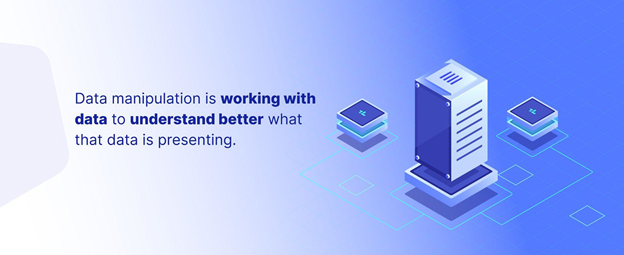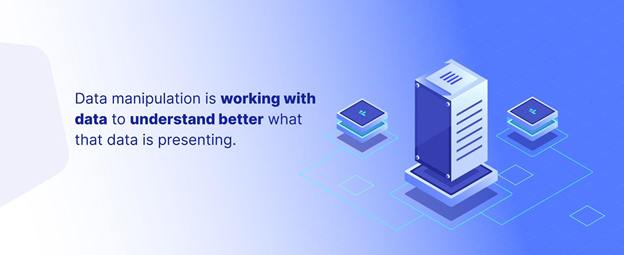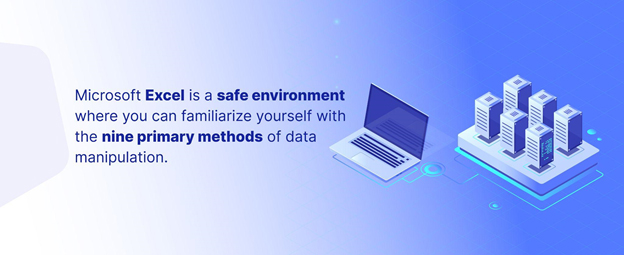Data is the primary driver behind business decisions, making it an essential element of every business. However, big data has grown to a point where there is so much data to manage that finding what you want or need can be like looking for a needle in a haystack.
Suppose you have structured data or other data only readable by a computer. In that case, data manipulation provides the means to work with the data and find the exact information you need to make decisions. Data manipulation isn’t nearly as complex as many other aspects of data management, but it can take a while to make full use of the process.
Data manipulation can range from incredibly easy to unbelievably complex. Many data manipulation tools are available to help deal with your data, no matter how much data you have. Whether you are dealing with financial data, project data, or any other essential data, you will use data manipulation to better target specific details to make your decisions.
What Is Data Manipulation?

Data manipulation is a process you have probably used before, even if only to work with your budget. Data manipulation is working with data (manipulating it) to understand better what that data is presenting. You manipulate data when you reorganize or pull data from a data source.
Data manipulation is not the same as data transformation, though both types can use raw data.
- Data manipulation is the process that helps you organize your current data so you can interpret it. When you think of data manipulation, think about Microsoft Excel because that is one of the most widely used tools for manipulating data.
- Data transformation is the process of cleaning up and structuring data for use. It is typically a part of the longer data migration process.
Both are types of data modification but at very different points in managing and analyzing data. The purpose of data manipulation is to make it easier to analyze the data.
One of the simplest examples of data manipulation is what you do when you work in Excel. You can sort and filter the data to display only specific data points. If anything is improperly formatted, it won’t display, so you lose that data point. The more data points you miss, the less accurate and complete the information is.
Most data manipulation is more complicated than working in Excel, but it is the same principle. In fact, you can manipulate data in Excel after pulling it from its source if you don’t have any other data manipulation tools available. There is nothing wrong with data manipulation techniques used for data analysis in Excel; however, Excel isn’t the only solution.
To better understand your raw data, you want to have the right data manipulation tools. Using a data migration service, at least initially, can help you understand how to work with your data. Data modification is a pretty straightforward process. Keep that in mind as we go into something a little more complicated.
The computer language SQL (short for Structured Query Language) is the most common data manipulation language, and it is used to pull data from a database. SQL is a relatively simple computer language to learn. There are four primary commands to initiate data manipulation.
- SELECT – This command selects the rows and columns you want to work with from the database.
- UPDATE – This command changes the existing data. For example, you can fix data errors or inconsistent formatting.
- INSERT – This command allows you to add more data to existing data or move existing data.
- DELETE – This command removes data, which is necessary if you have obsolete or duplicate data. If you have a lot of historical data, you will probably use this command more often.
Note that the commands are in all caps. This is more than just to highlight them. When you write a command in SQL (or nearly any other language), you write the commands in all caps so that the computer can interpret it as a command. If you want to learn a data manipulation language, you’ll need to at least know the primary commands and how they must be entered.
Don’t worry; you don’t have to learn SQL or any other data manipulation language. There are several different options to manipulate data that are far more user-friendly. Data analysis should be readily available to everyone because accounting users and project managers shouldn’t need to be IT experts.
Why Is Data Manipulation Useful?

One of the primary uses for data manipulation is to make better-informed decisions as a part of business operations. There is a wide range of uses, from interpreting website traffic to making decisions about marketing, sales, personnel, and project projection, among other business decisions.
Even small businesses have a lot of data to interpret. It is nearly impossible to understand your data without manipulating it first. You rarely need all the data present, and you don’t want a data dump because you will get a lot of information you don’t need.
Data manipulation aims to organize vast amounts of information, including current and historical data. The following are the primary uses to keep in mind as you consider what data manipulation services or tools you need.
- You can make the data more consistent. Consistent data is essential to understanding what the data is presenting. Since data usually comes from multiple sources, it often doesn’t have the same data formatting or consistency to make it easier to review. Dealing with those differences is much easier when you first manipulate the data.
- The best way to run projects more effectively and efficiently is to understand projects that have been completed. There is a lot to learn from past projects, especially if you want to avoid repeating past mistakes.
- Deleting obsolete, irrelevant, and redundant data is necessary to keep your data clean. Instead of going through your big data manually (something that would be an impossible task), you can use data manipulation to take care of it in a fraction of the time.
Data manipulation is a process to help you deal with all the data so that you can begin analyzing data and making decisions. It can be used for anything within your company, but it is best when working with numbers to make decisions about your business.
Methods of Data Manipulation

There are nine primary ways of manipulating data, most of which you already know. Some are more advanced methods of the data manipulation process, but by learning about them here, you’ll be more effective in using this process.
- Sorting is probably the most popular method of data manipulation. When you sort data, it arranges the information in alpha-numeric order. You can adjust the data to ascending or descending order depending on where your focus is.
- Filtering is another popular data manipulation method you have likely used with some frequency. When you filter data, you can hide or remove data that doesn’t meet specific criteria. For example, suppose you are trying to analyze a particular marketing campaign. In that case, you can specify sales, new customers, or repeat customers based on specific dates (when the campaign started until it ended).
- Grouping lets you organize your data set into groups to understand the relationships between different factors better. If you want to identify patterns, customer demographics, or trends, grouping is the best method to use. This is particularly useful when analyzing financial data and project data as you will want to compare different aspects of the data easily. Trend analysis often relies on the grouping method to look at the various elements.
- Pivoting allows you to change a table to adjust its focus. You can drill down to get more details about your company’s monthly earnings based on different factors. You can then pivot those factors to be the primary focus to get more details about them. Pivoting is helpful as it can help illuminate points you hadn’t considered. It allows you to remove irrelevant information, bringing your focus to a precise data set. Pivoting is one of the less commonly used methods of data manipulation, but well worth learning about.
- Changing data types means adjusting the type of data you are viewing, which will almost always be text or numbers. For example, if you are only interested in looking at names, you can switch to only viewing text data, or you can look at financials with text only. Once you select between these two types, you can better refine it to show text, numbers, date/time, logic, and objects/embedding.
- Transposing is a lesser-known data manipulation method that lets you shift or switch columns and rows. This method isn’t one you are likely to use unless you just want to make some adjustments to your data.
- Inserting columns and rows is something you may use when working with data from several different data sources. You probably don’t need to combine everything into a single data set, so you can add just the relevant columns and rows to incorporate more relevant information.
- Adding columns and rows is just what it sounds like – you can add new columns and rows. These cells can be new data from other data sources or information that someone has but hasn’t recorded. There are so many reasons to add these details.
- Naming columns and rows makes it easier to quickly assess what you are looking at when you are reviewing data. You’ve probably dealt with data sets that failed to identify these parts of the data, making the data almost irrelevant.
All these data manipulation methods are part of Excel, which may help you make sense of them. To learn more about them, you can open an old spreadsheet and learn how they work in Excel. From there, you can incorporate, insert, delete, or move data to see how it works. While you are there, you can also work with basic math functions to test out the different totals you get with the various methods of data manipulation.
Excel is a safe environment where you can familiarize yourself with these methods, so you know how to manipulate data in other settings. It is particularly handy if you have duplicate spreadsheet entries. When you have data pulled from multiple sources, you will probably have duplicate spreadsheet entries, so you only want to remove the duplicates in your spreadsheet, not from the various sources. You can safely delete duplicates in Excel without worrying about deleting data from different sources.
Examples

The easiest example of data manipulation is sorting your data. It allows you to put it in alphabetic or numeric order to quickly review information. You can sort by numeric order to see which product is selling best or where the most amount of time is going on a project. You would probably sort by alphabetical order if you wanted to look over a list to see who is in a particular department.
Data manipulation is essential to understanding website traffic. With consistent data and organization, you can determine what you need to do to improve your website traffic. Your web server logs help you manipulate data to understand your traffic and customers’ numbers, trends, and performance.
Financial data is easily one of the areas where data manipulation is necessary to make decisions. Data manipulation is essential to forecasting a business’ financial aspects, including stocks and future tax obligations. People in finance, sales, and marketing rely on data manipulation to understand trends, expenses, product and campaign performance, and financial patterns.
Data manipulation is also good to have on a personal level because you can use it for all the same purposes. You should take time to conduct your own in depth analysis of your finances regularly. It is a great way to understand current stock performance and analyze trends or help you get your budget straight. Personal software will do most of the data manipulation so that you can focus on the results.
Final Thoughts
Data manipulation is something that everyone does, even if it is only on a personal level. The problem is that many people feel overwhelmed because there is a lot of data to manipulate. For data to be valuable, you have to plan your path forward, and it’s not quite as easy as it sounds.
Fortunately, we have experts on hand to help you understand and use the data manipulation process and let you know what data manipulation tools are available to you. We can help you turn vast amounts of data into useful information. If you are interested in data manipulation services to help you maximize your data use, speak to our specialists.

